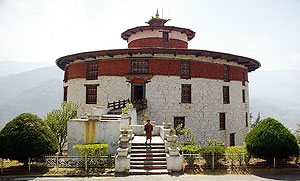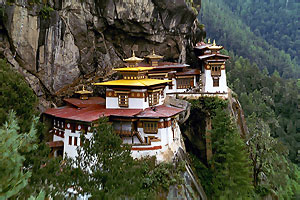|
|
Paro Attractions |
|
Tourist Attractions in Paro
The various tourist attractions in Paro are the National
Museum, Philatellic Gallery, Taktsang Monastery, Rimpung Dzong
and Thongdroel. |
|
|
|
National Museum
The National Museum is the main tourist attraction in
Paro. This national museum is housed in Ta dzong which
is an ancient watchtower. The white and brown ringed
fortress, built in 1657 was made as the National Museum
in 1967. This museum is the country’s only archive. The
museum has the collection of old coins, stamps, birds
and mammals and the costumes of the people of Bhutan at
various times of its history. The ancient weapons
including the |
 |
|
|
bows used in
archery, brass and copper house wares and a good display of
ancient Bhutanese art and artefacts. A fragment of moon’s
surface brought by Neil Armstrong in July 1969 is also
displayed in the museum.
Philatellic Gallery
The Philatellic Gallery near the top of the museum is also one
of the great tourist interest. This gallery contains a large
collection of stamps. Stamps are a big business in Bhutan and
are an important source of foreign exchange. The postage
stamps are also brought by visitors as they cover a wide range
of subjects and are beautifully printed. On 30 October 1967,
Bhutan issued the world’s first three-dimensional stamps in
commemoration of man’s conquest of space. The world’s first
steel stamps, printed on hair thin steel foil, reflects the
importance of steel industry in the economic development of
Bhutan. Silk stamps with religious motifs of Bhutan were also
printed. The king of Bhutan has been featured on a series of
gold embossed coin stamps. Bhutan was also the first country
to introduce “Talking Stamps” in 1973. These stamps were
gummed miniature phonograph records playing Bhutan’s national
anthem. However, in spite of having some of the finest postage
stamps, Bhutan has no strong postal system. Even today,
runners carry messages across the country where no road links
exist. |
|
|
|
Taktsang Monastery
The Taktsang Monastery means the Tiger’s Nest. This
monastery is the most important religious site for the
Bhutanese people, and located at a distance of around 80
km from Paro, precariously perched on the edge of a
cliff. This monastery has been built around the cave
where Guru Rimpoche and later his follower Dubthak
Singye meditated. It clings to a cliff of rock which is
about 800 meters above the valley. A visit to this
monastery is a challenge, exhausting, thrilling and
|
 |
|
|
mystical.
According to the legend, Guru Padmasambhava arrived more than
a million ago on the back of a tiger from Tibet to this place.
He mediated in a cave for around two months where this
monastery was built later. This monastery can be visited by
either trekking or on horse. The Taktsang monastery is a
pilgrimage place that every Bhutanese tries to visit at least
once in a lifetime.
Rimpung Dzong
The Rimpung Dzong or Paro Dzong is situated on the hillside
above the gently meandering Paro River. Rimpung means the heap
of jewels. Paro Dzong is the symbolic centre of religious and
secular affairs of entire Paro Valley. This fortress offers
the view of the Paro Valley stretched out below. Some
centuries ago, it was an unreachable fortress that repelled
invasions from Tibet. But, today, it houses the Paro monastic
body and the office of the Dzongda (district commissioner) and
Thrimpon (district judge). Consecrated in 1646, the Dzong is
an architectural wonder that showcases the cultural strength
of kingdom's strength.
Thongdroel
The Thongdroel is the most sacred giant which is painted and
an appliquéd scroll. This giant depicts the eight
manifestations of Guru Padmasambhava with its two attendants,
Khendu Yeshey Tsogyel and Khandu Minona Rawa. It is displayed
for a few hours on the concluding days of the Paro Tesechu
festival held from the 10th to 14th day of the Bhutanese lunar
calendar’s second month. It is unfurled before dawn for the
few hours before the direct rays of the sun strikes it. This
giant is about 400 years old, and can be easily damaged by sun
rays. |
|